weight Abarth 500 2020 Owner handbook (in English)
[x] Cancel search | Manufacturer: ABARTH, Model Year: 2020, Model line: 500, Model: Abarth 500 2020Pages: 196, PDF Size: 3.53 MB
Page 72 of 196
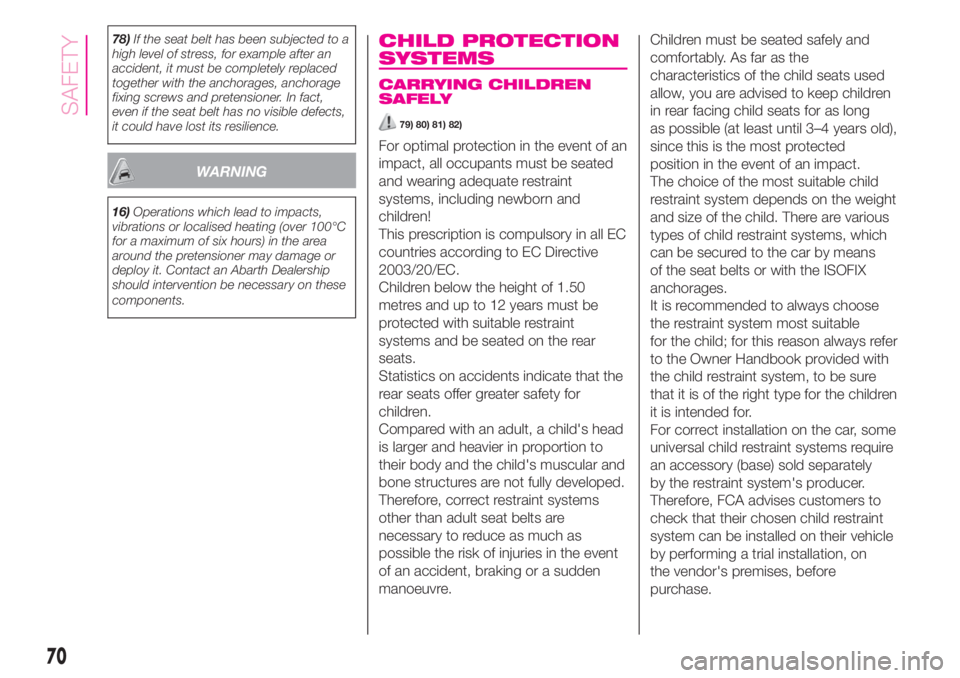
78)If the seat belt has been subjected to a
high level of stress, for example after an
accident, it must be completely replaced
together with the anchorages, anchorage
fixing screws and pretensioner. In fact,
even if the seat belt has no visible defects,
it could have lost its resilience.
WARNING
16)Operations which lead to impacts,
vibrations or localised heating (over 100°C
for a maximum of six hours) in the area
around the pretensioner may damage or
deploy it. Contact an Abarth Dealership
should intervention be necessary on these
components.
CHILD PROTECTION
SYSTEMS
CARRYING CHILDREN
SAFELY
79) 80) 81) 82)
For optimal protection in the event of an
impact, all occupants must be seated
and wearing adequate restraint
systems, including newborn and
children!
This prescription is compulsory in all EC
countries according to EC Directive
2003/20/EC.
Children below the height of 1.50
metres and up to 12 years must be
protected with suitable restraint
systems and be seated on the rear
seats.
Statistics on accidents indicate that the
rear seats offer greater safety for
children.
Compared with an adult, a child's head
is larger and heavier in proportion to
their body and the child's muscular and
bone structures are not fully developed.
Therefore, correct restraint systems
other than adult seat belts are
necessary to reduce as much as
possible the risk of injuries in the event
of an accident, braking or a sudden
manoeuvre.Children must be seated safely and
comfortably. As far as the
characteristics of the child seats used
allow, you are advised to keep children
in rear facing child seats for as long
as possible (at least until 3–4 years old),
since this is the most protected
position in the event of an impact.
The choice of the most suitable child
restraint system depends on the weight
and size of the child. There are various
types of child restraint systems, which
can be secured to the car by means
of the seat belts or with the ISOFIX
anchorages.
It is recommended to always choose
the restraint system most suitable
for the child; for this reason always refer
to the Owner Handbook provided with
the child restraint system, to be sure
that it is of the right type for the children
it is intended for.
For correct installation on the car, some
universal child restraint systems require
an accessory (base) sold separately
by the restraint system's producer.
Therefore, FCA advises customers to
check that their chosen child restraint
system can be installed on their vehicle
by performing a trial installation, on
the vendor's premises, before
purchase.
70
SAFETY
Page 73 of 196
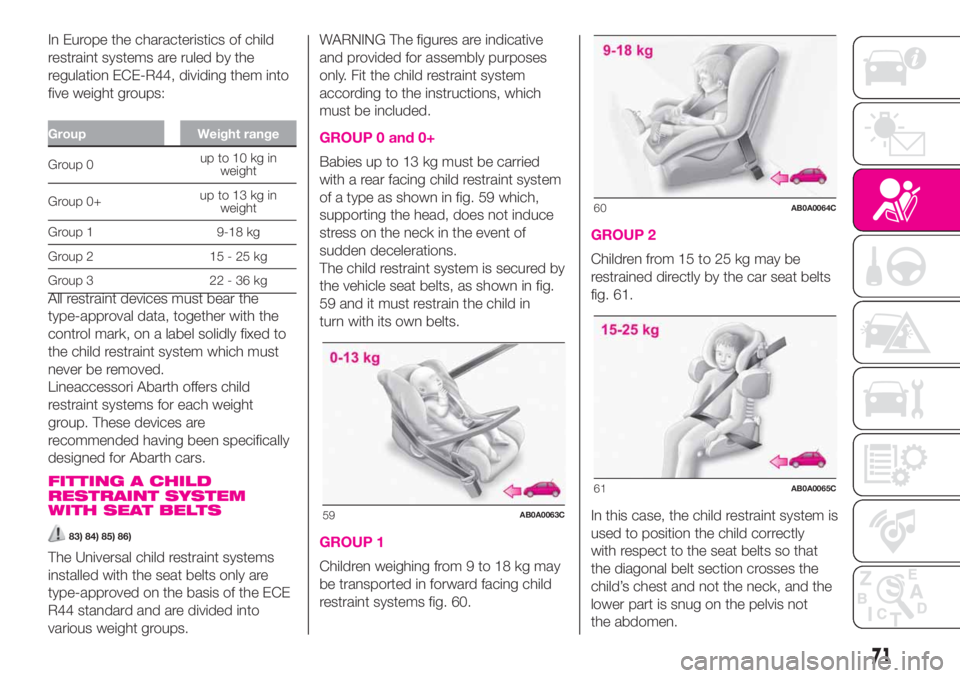
In Europe the characteristics of child
restraint systems are ruled by the
regulation ECE-R44, dividing them into
five weight groups:
Group Weight range
Group 0up to 10 kg in
weight
Group 0+up to 13 kg in
weight
Group 1 9-18 kg
Group 2 15 - 25 kg
Group 3 22 - 36 kg
All restraint devices must bear the
type-approval data, together with the
control mark, on a label solidly fixed to
the child restraint system which must
never be removed.
Lineaccessori Abarth offers child
restraint systems for each weight
group. These devices are
recommended having been specifically
designed for Abarth cars.
FITTING A CHILD
RESTRAINT SYSTEM
WITH SEAT BELTS
83) 84) 85) 86)
The Universal child restraint systems
installed with the seat belts only are
type-approved on the basis of the ECE
R44 standard and are divided into
various weight groups.WARNING The figures are indicative
and provided for assembly purposes
only. Fit the child restraint system
according to the instructions, which
must be included.
GROUP 0 and 0+
Babies up to 13 kg must be carried
with a rear facing child restraint system
of a type as shown in fig. 59 which,
supporting the head, does not induce
stress on the neck in the event of
sudden decelerations.
The child restraint system is secured by
the vehicle seat belts, as shown in fig.
59 and it must restrain the child in
turn with its own belts.
GROUP 1
Children weighing from 9 to 18 kg may
be transported in forward facing child
restraint systems fig. 60.
GROUP 2
Children from 15 to 25 kg may be
restrained directly by the car seat belts
fig. 61.
In this case, the child restraint system is
used to position the child correctly
with respect to the seat belts so that
the diagonal belt section crosses the
child’s chest and not the neck, and the
lower part is snug on the pelvis not
the abdomen.
59AB0A0063C
60AB0A0064C
61AB0A0065C
71
Page 75 of 196
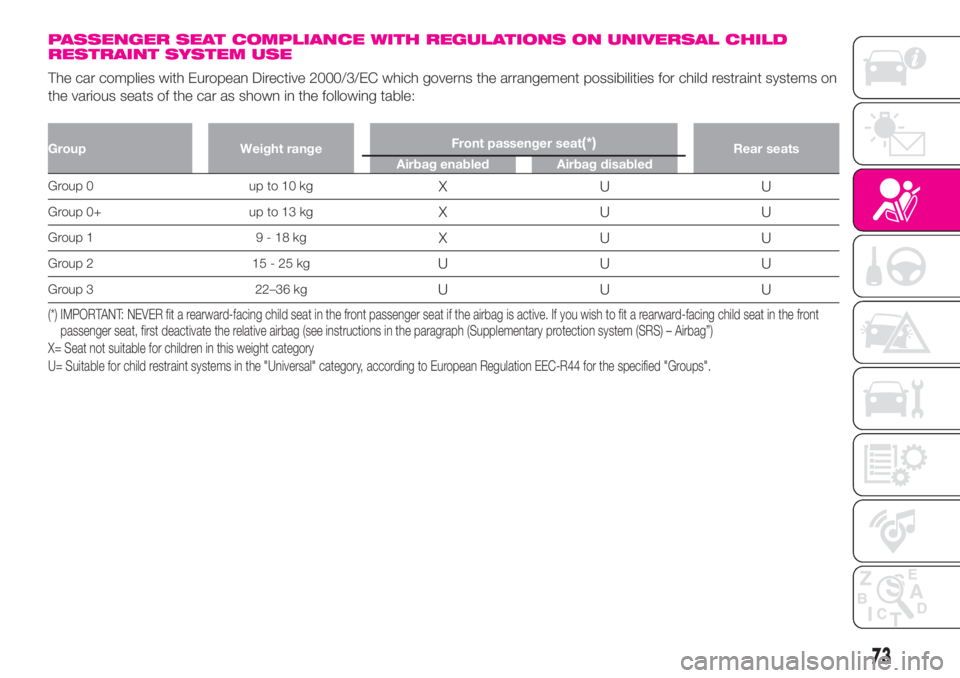
PASSENGER SEAT COMPLIANCE WITH REGULATIONS ON UNIVERSAL CHILD
RESTRAINT SYSTEM USE
The car complies with European Directive 2000/3/EC which governs the arrangement possibilities for child restraint systems on
the various seats of the car as shown in the following table:
Group Weight rangeFront passenger seat(*)Rear seats
Airbag enabled Airbag disabled
Group0 upto10kgXUU
Group 0+ up to 13 kgXUU
Group 1 9 - 18 kgXUU
Group 2 15 - 25 kgUUU
Group 3 22–36 kgUUU
(*) IMPORTANT: NEVER fit a rearward-facing child seat in the front passenger seat if the airbag is active. If you wish to fit a rearward-facing child seat in the front
passenger seat, first deactivate the relative airbag (see instructions in the paragraph (Supplementary protection system (SRS) – Airbag”)
X= Seat not suitable for children in this weight category
U= Suitable for child restraint systems in the "Universal" category, according to European Regulation EEC-R44 for the specified "Groups".
73
Page 76 of 196
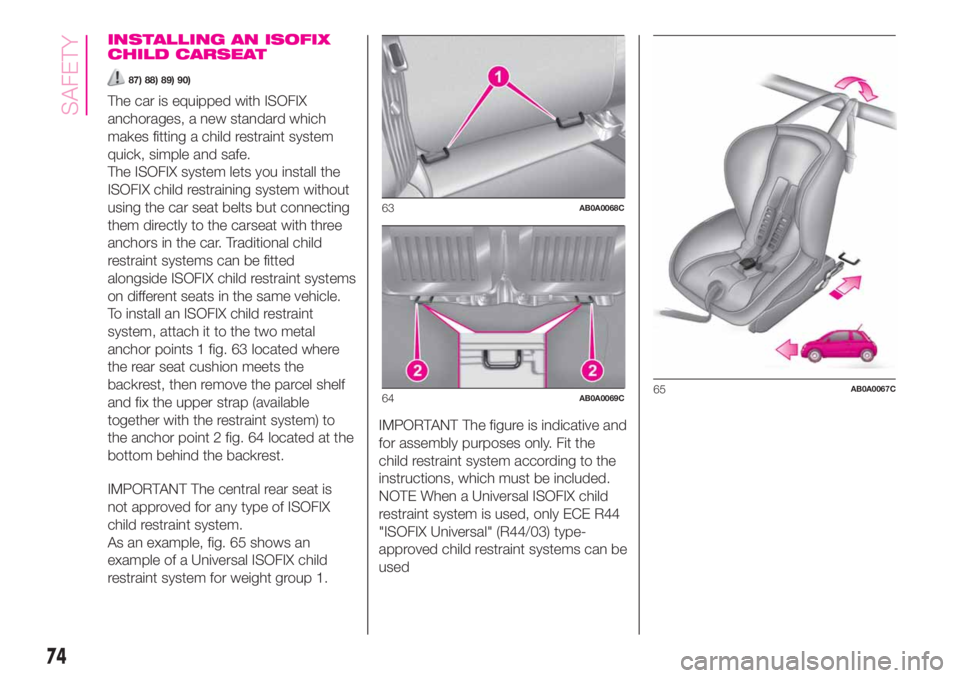
INSTALLING AN ISOFIX
CHILD CARSEAT
87) 88) 89) 90)
The car is equipped with ISOFIX
anchorages, a new standard which
makes fitting a child restraint system
quick, simple and safe.
The ISOFIX system lets you install the
ISOFIX child restraining system without
using the car seat belts but connecting
them directly to the carseat with three
anchors in the car. Traditional child
restraint systems can be fitted
alongside ISOFIX child restraint systems
on different seats in the same vehicle.
To install an ISOFIX child restraint
system, attach it to the two metal
anchor points 1 fig. 63 located where
the rear seat cushion meets the
backrest, then remove the parcel shelf
and fix the upper strap (available
together with the restraint system) to
the anchor point 2 fig. 64 located at the
bottom behind the backrest.
IMPORTANT The central rear seat is
not approved for any type of ISOFIX
child restraint system.
As an example, fig. 65 shows an
example of a Universal ISOFIX child
restraint system for weight group 1.IMPORTANT The figure is indicative and
for assembly purposes only. Fit the
child restraint system according to the
instructions, which must be included.
NOTE When a Universal ISOFIX child
restraint system is used, only ECE R44
"ISOFIX Universal" (R44/03) type-
approved child restraint systems can be
used
63AB0A0068C
64AB0A0069C65AB0A0067C
74
SAFETY
Page 77 of 196
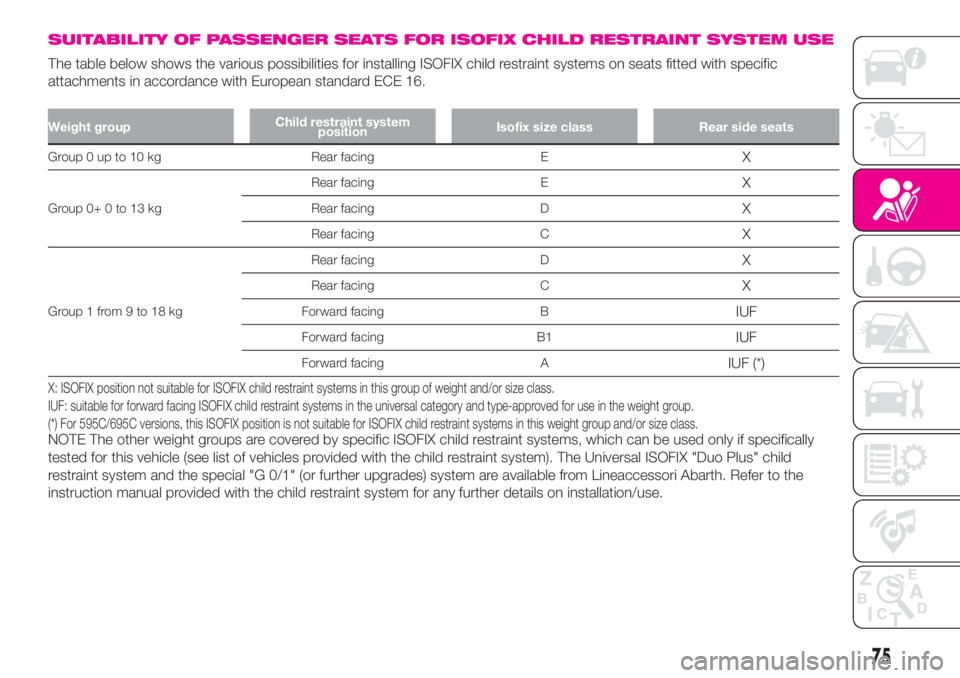
SUITABILITY OF PASSENGER SEATS FOR ISOFIX CHILD RESTRAINT SYSTEM USE
The table below shows the various possibilities for installing ISOFIX child restraint systems on seats fitted with specific
attachments in accordance with European standard ECE 16.
Weight groupChild restraint system
positionIsofix size class Rear side seats
Group 0 up to 10 kg Rear facing EX
Group0+0to13kgRear facing E
X
Rear facing DX
Rear facing CX
Group1from9to18kgRear facing D
X
Rear facing CX
Forward facing BIUF
Forward facing B1IUF
Forward facing AIUF (*)
X: ISOFIX position not suitable for ISOFIX child restraint systems in this group of weight and/or size class.
IUF: suitable for forward facing ISOFIX child restraint systems in the universal category and type-approved for use in the weight group.
(*) For 595C/695C versions, this ISOFIX position is not suitable for ISOFIX child restraint systems in this weight group and/or size class.
NOTE The other weight groups are covered by specific ISOFIX child restraint systems, which can be used only if specifically
tested for this vehicle (see list of vehicles provided with the child restraint system). The Universal ISOFIX "Duo Plus" child
restraint system and the special "G 0/1" (or further upgrades) system are available from Lineaccessori Abarth. Refer to the
instruction manual provided with the child restraint system for any further details on installation/use.
75
Page 136 of 196
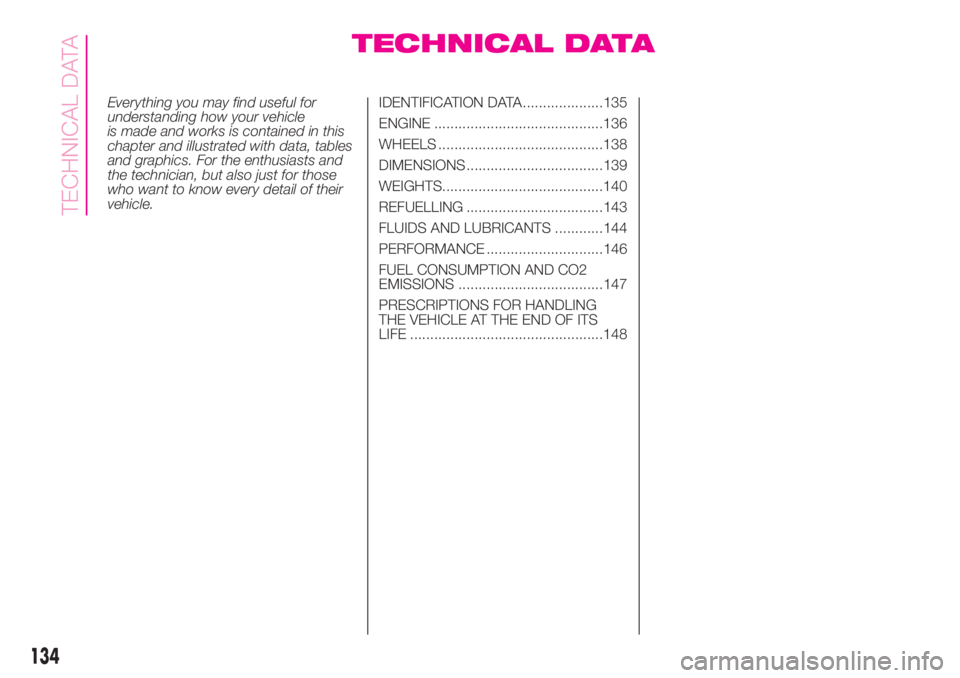
TECHNICAL DATA
Everything you may find useful for
understanding how your vehicle
is made and works is contained in this
chapter and illustrated with data, tables
and graphics. For the enthusiasts and
the technician, but also just for those
who want to know every detail of their
vehicle.IDENTIFICATION DATA....................135
ENGINE ..........................................136
WHEELS .........................................138
DIMENSIONS ..................................139
WEIGHTS........................................140
REFUELLING ..................................143
FLUIDS AND LUBRICANTS ............144
PERFORMANCE .............................146
FUEL CONSUMPTION AND CO2
EMISSIONS ....................................147
PRESCRIPTIONS FOR HANDLING
THE VEHICLE AT THE END OF ITS
LIFE ................................................148
134
TECHNICAL DATA
Page 137 of 196
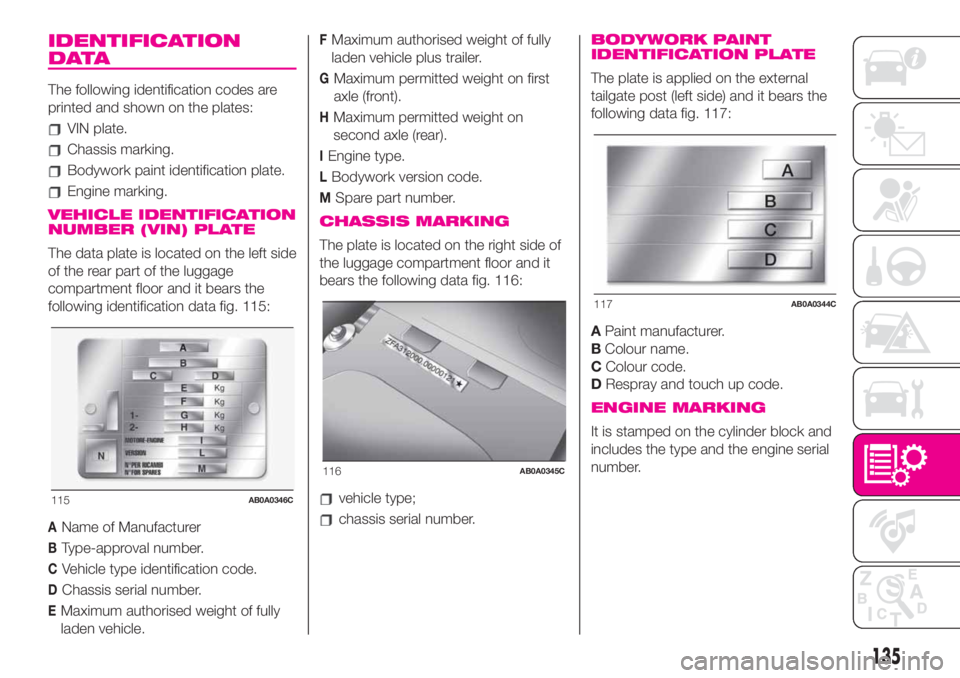
IDENTIFICATION
DATA
The following identification codes are
printed and shown on the plates:
VIN plate.
Chassis marking.
Bodywork paint identification plate.
Engine marking.
VEHICLE IDENTIFICATION
NUMBER (VIN) PLATE
The data plate is located on the left side
of the rear part of the luggage
compartment floor and it bears the
following identification data fig. 115:
AName of Manufacturer
BType-approval number.
CVehicle type identification code.
DChassis serial number.
EMaximum authorised weight of fully
laden vehicle.
FMaximum authorised weight of fully
laden vehicle plus trailer.
GMaximum permitted weight on first
axle (front).
HMaximum permitted weight on
second axle (rear).
IEngine type.
LBodywork version code.
MSpare part number.
CHASSIS MARKING
The plate is located on the right side of
the luggage compartment floor and it
bears the following data fig. 116:
vehicle type;
chassis serial number.
BODYWORK PAINT
IDENTIFICATION PLATE
The plate is applied on the external
tailgate post (left side) and it bears the
following data fig. 117:
APaint manufacturer.
BColour name.
CColour code.
DRespray and touch up code.
ENGINE MARKING
It is stamped on the cylinder block and
includes the type and the engine serial
number.
115AB0A0346C
116AB0A0345C
117AB0A0344C
135
Page 142 of 196
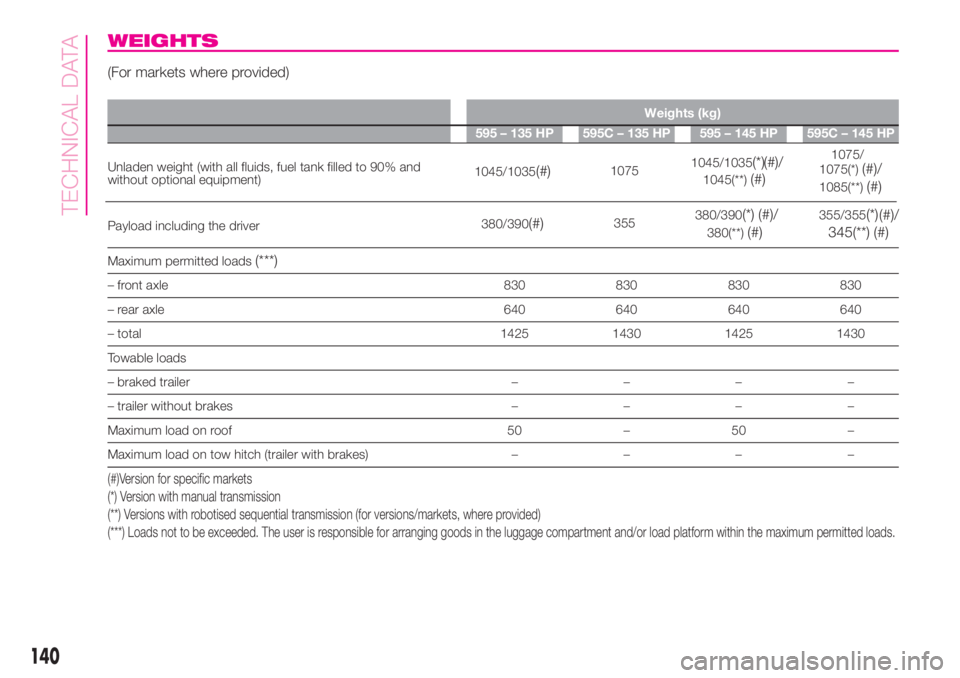
WEIGHTS
(For markets where provided)
Weights (kg)
595 – 135 HP 595C – 135 HP 595 – 145 HP 595C – 145 HP
Unladen weight (with all fluids, fuel tank filled to 90% and
without optional equipment)
Payload including the driver
Maximum permitted loads
(***)
– front axle 830 830 830 830
– rear axle 640 640 640 640
– total 1425 1430 1425 1430
Towable loads
– braked trailer––––
– trailer without brakes––––
Maximum load on roof 50 – 50 –
Maximum load on tow hitch (trailer with brakes)––––
(#)Version for specific markets
(*) Version with manual transmission
(**) Versions with robotised sequential transmission (for versions/markets, where provided)
(***) Loads not to be exceeded. The user is responsible for arranging goods in the luggage compartment and/or load platform within the maximum permitted loads.
140
TECHNICAL DATA
1045/1035(#)10751045/1035(*)
(#)/
1045(**)(#)
1075/
1075(*)(#)/
1085(**)(#)
380/390(#)355380/390(*) (#)/
380(**)(#)
355/355(*)
(#)/
345(**) (#)
Page 143 of 196
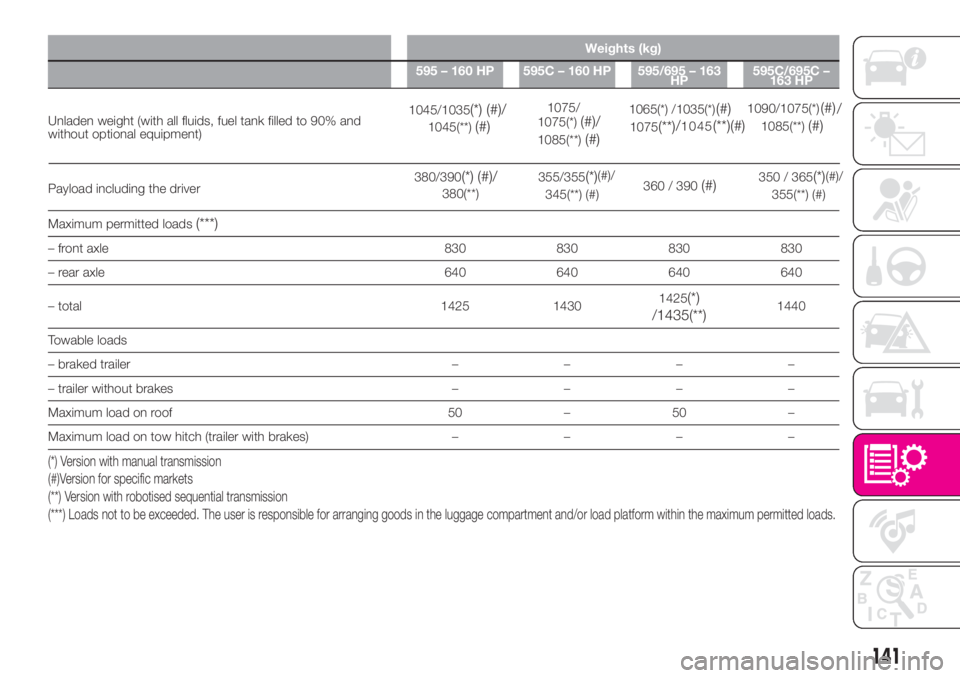
Weights (kg)
595 – 160 HP 595C – 160 HP595/695 – 163
HP595C/695C –
163 HP
Unladen weight (with all fluids, fuel tank filled to 90% and
without optional equipment)
Payload including the driver
Maximum permitted loads
(***)
– front axle 830 830 830 830
– rear axle 640 640 640 640
– total 1425 14301425
(*)
/1435(**)1440
Towable loads
– braked trailer––––
– trailer without brakes––––
Maximum load on roof 50 – 50 –
Maximum load on tow hitch (trailer with brakes)––––
(*) Version with manual transmission
(#)Version for specific markets
(**) Version with robotised sequential transmission
(***) Loads not to be exceeded. The user is responsible for arranging goods in the luggage compartment and/or load platform within the maximum permitted loads.
141
1045/1035(*) (#)
/
1045(**)(#)
1075/
1075(*)(#)/
1085(**)(#)
1065(*) /1035(*)(#)
1075(**)/1045(**)(#)
1090/1075(*)(#)
/
1085(**)(#)
380/390(*) (#)/
380(**)355/355
(*)(#)/
345(**) (#)360 / 390(#)350 / 365(*)(#)/
355(**) (#)
Page 144 of 196
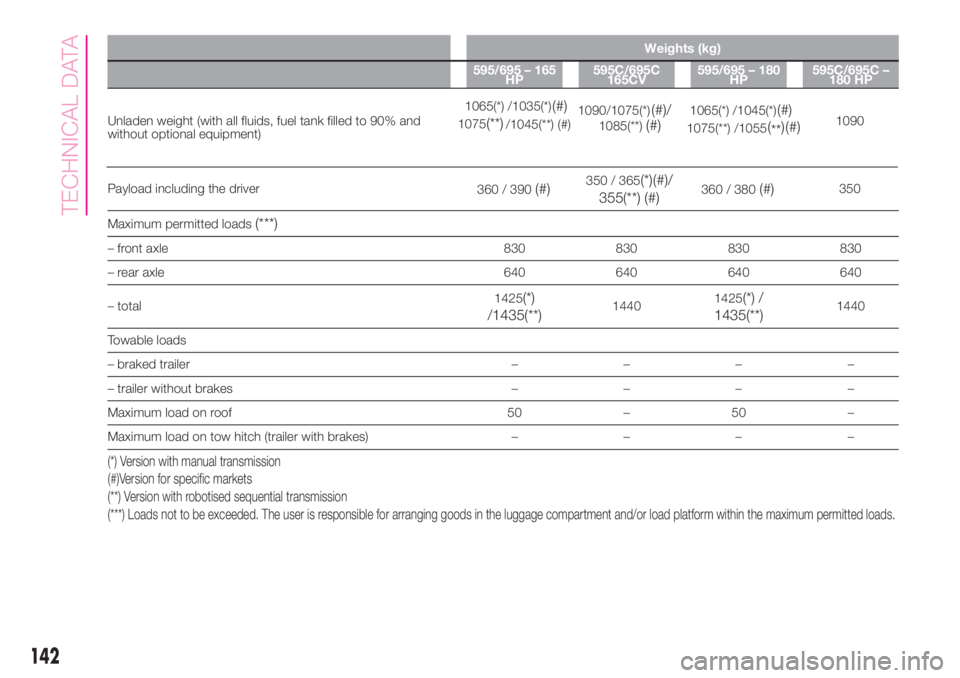
Weights (kg)
595/695 – 165
HP595C/695C
165CV595/695 – 180
HP595C/695C –
180 HP
Unladen weight (with all fluids, fuel tank filled to 90% and
without optional equipment)
Payload including the driver
Maximum permitted loads
(***)
– front axle 830 830 830 830
– rear axle 640 640 640 640
– total1425
(*)
/1435(**)14401425(*) /
1435(**)1440
Towable loads
– braked trailer––––
– trailer without brakes––––
Maximum load on roof 50 – 50 –
Maximum load on tow hitch (trailer with brakes)––––
(*) Version with manual transmission
(#)Version for specific markets
(**) Version with robotised sequential transmission
(***) Loads not to be exceeded. The user is responsible for arranging goods in the luggage compartment and/or load platform within the maximum permitted loads.
142
TECHNICAL DATA
1065(*) /1035(*)(#)
1075(**)/1045(**) (#)1090/1075(*)(#)
/1085(**)(#)1065(*) /1045(*)(#)
1075(**) /1055(
**) (#)1090
360 / 390
(#)350 / 365(*)
(#)/
355(**) (#)360 / 380(#)350